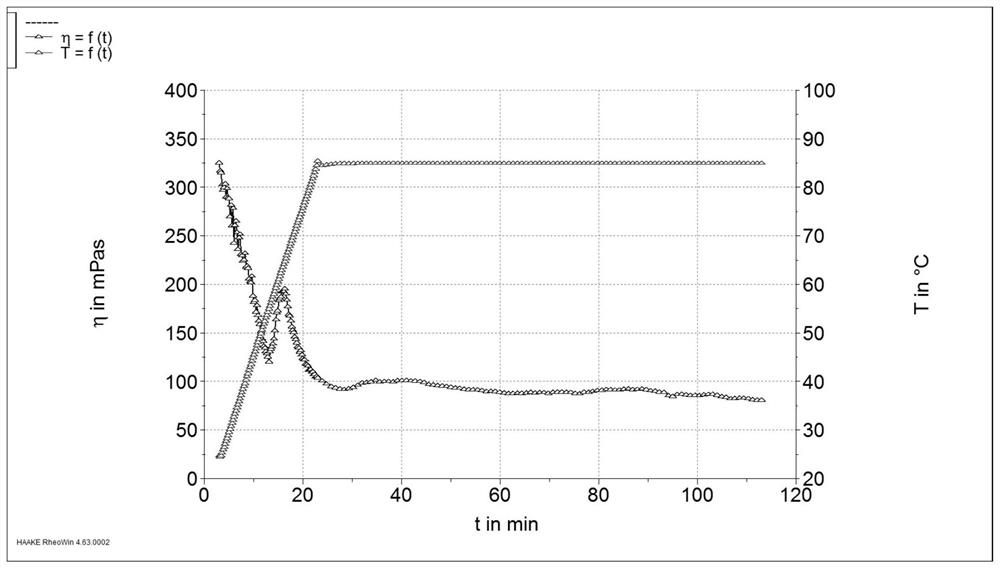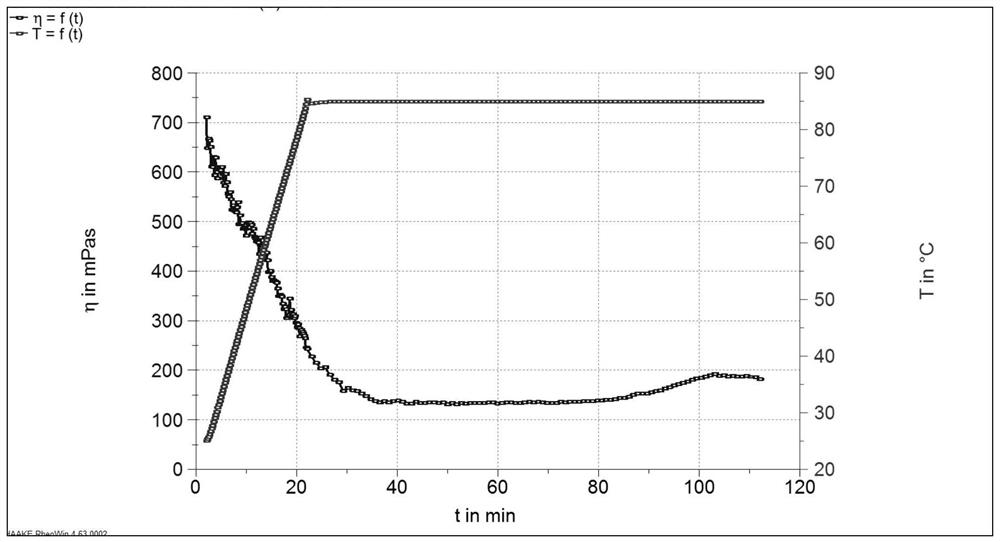Preparation method of organic aluminum cross-linking agent capable of being cross-linked with W/O inverse emulsion type drag reducer
An inverse emulsion and organoaluminum technology, applied in chemical instruments and methods, drilling compositions, etc., can solve problems such as difficulty in online mixing, reduce labor intensity, facilitate on-site operation, and simplify liquid dispensing process. Effect
- Summary
- Abstract
- Description
- Claims
- Application Information
AI Technical Summary
Problems solved by technology
Method used
Image
Examples
Embodiment 1
[0022] A preparation method of an organoaluminum crosslinking agent crosslinkable with a W / O inverse emulsion type drag reducer, comprising the following steps:
[0023] (1) 6g of polyaluminum chloride and 2g of aluminum hypoacetate are dissolved in 92g of potassium chloride brine with a mass fraction of 1% in a reactor, stirred until completely dissolved, and mixed solution I is prepared;
[0024] (2) Heat the mixed solution I in step (1) to 80° C., slowly add 6 g of sodium gluconate to the mixed solution I while stirring to obtain the mixed solution II;
[0025] (3) The mixed solution II in step (2) was reacted at 80° C. for 3 hours at a constant temperature and then cooled to room temperature to obtain a light yellow uniform transparent clear liquid which was the organoaluminum crosslinking agent.
[0026] The polyaluminum chloride and aluminum hypoacetate in the preparation method are organoaluminum and provide chloride ions; sodium gluconate is an organic matter and provi...
Embodiment 2
[0028] A preparation method of an organoaluminum crosslinking agent crosslinkable with a W / O inverse emulsion type drag reducer, comprising the following steps:
[0029] (1) Dissolve 5g of polyaluminum chloride and 1g of aluminum hypoacetate in 94g of sodium chloride brine with a mass fraction of 1% in a reactor, stir until completely dissolved, and prepare mixed solution I;
[0030] (2) Heat the mixed solution I in step (1) to 90° C., slowly add 5 g of sodium gluconate and 1 g of triethanolamine to the mixed solution I while stirring to obtain the mixed solution II;
[0031] (3) The mixed liquid II in step (2) was reacted at 90° C. for 4 hours at a constant temperature and then cooled to room temperature to obtain a light yellow uniform transparent clear liquid which was the organoaluminum crosslinking agent.
[0032] The polyaluminum chloride and aluminum hypoacetate in the preparation method are organoaluminum, providing chloride ions; sodium gluconate and triethanolamine a...
Embodiment 3
[0034] A preparation method of an organoaluminum crosslinking agent crosslinkable with a W / O inverse emulsion type drag reducer, comprising the following steps:
[0035] (1) 6g of polyaluminum chloride and 2g of aluminum hypoacetate are dissolved in 92g of potassium chloride brine with a mass fraction of 2% in a reactor, stirred until completely dissolved, and mixed solution I is prepared;
[0036] (2) Heat the mixed solution I in step (1) to 80° C., slowly add 5 g of sodium gluconate, 1 g of triethanolamine and 1 g of sodium acetate to the mixed solution I while stirring to obtain the mixed solution II;
[0037] (3) The mixed solution II in step (2) was reacted at 80° C. for 3 hours at a constant temperature and then cooled to room temperature to obtain a light yellow uniform transparent clear liquid which was the organoaluminum crosslinking agent.
[0038] The polyaluminum chloride and aluminum hypoacetate in the preparation method are organoaluminum, providing chloride ions...
PUM
| Property | Measurement | Unit |
|---|---|---|
| viscosity | aaaaa | aaaaa |
Abstract
Description
Claims
Application Information
 Login to View More
Login to View More - R&D
- Intellectual Property
- Life Sciences
- Materials
- Tech Scout
- Unparalleled Data Quality
- Higher Quality Content
- 60% Fewer Hallucinations
Browse by: Latest US Patents, China's latest patents, Technical Efficacy Thesaurus, Application Domain, Technology Topic, Popular Technical Reports.
© 2025 PatSnap. All rights reserved.Legal|Privacy policy|Modern Slavery Act Transparency Statement|Sitemap|About US| Contact US: help@patsnap.com


